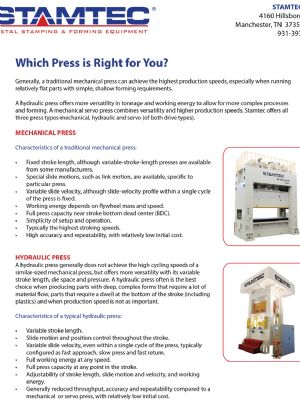 Stamping Presses
Stamping PressesWhich Press is Right for You?
 LOG IN TO DOWNLOAD WHITE PAPER
LOG IN TO DOWNLOAD WHITE PAPER
Generally, a traditional mechanical press can achieve the highest production speeds, especially when running relatively at parts with simple, shallow forming requirements.
A hydraulic press off ers more versatility in tonnage and working energy to allow for more complex processes and forming. A mechanical servo press combines versatility and higher production speeds. Stamtec offers all three press types—mechanical, hydraulic and servo (of both drive types).
Mechanical Press
Characteristics of a traditional mechanical press:
- Fixed stroke length, although variable-stroke-length presses are available from some manufacturers.
- Special slide motions, such as link motion, are available, specifi c to particular press.
- Variable slide velocity, although slide-velocity pro file within a single cycle of the press is fixed.
- Working energy depends on flywheel mass and speed.
- Full press capacity near stroke bottom dead center (BDC).
- Simplicity of setup and operation.
- Typically the highest stroking speeds.
- High accuracy and repeatability, with relatively low initial cost.






Comments
Must be logged in to post a comment. Sign in or Create an Account
There are no comments posted.